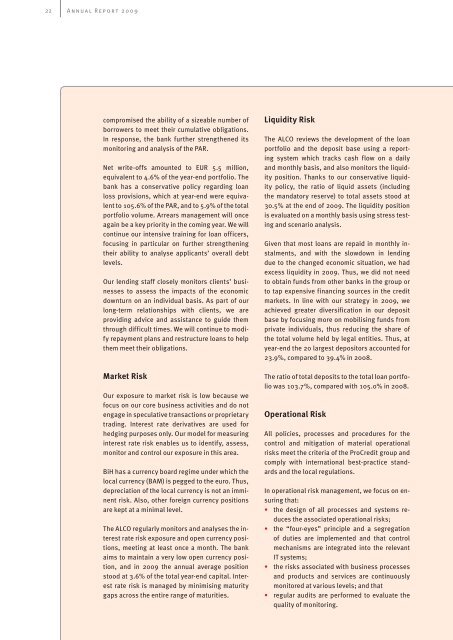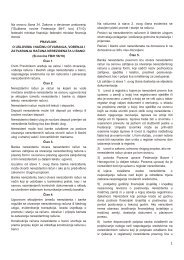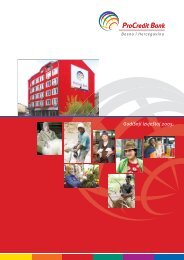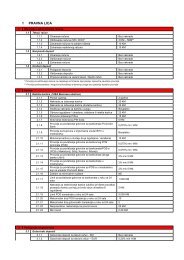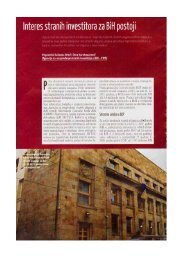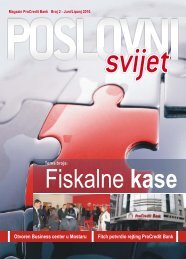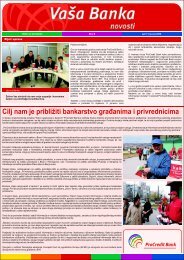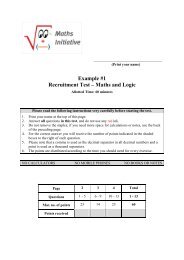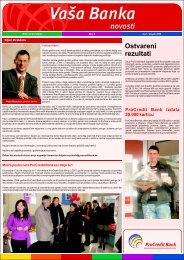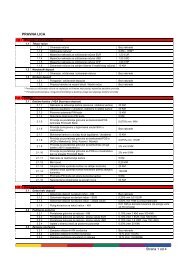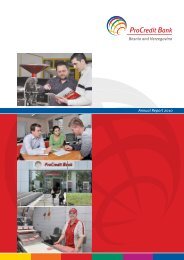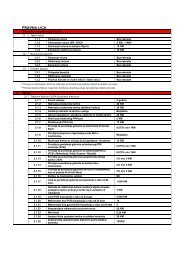Annual Report 2009 - ProCredit
Annual Report 2009 - ProCredit
Annual Report 2009 - ProCredit
You also want an ePaper? Increase the reach of your titles
YUMPU automatically turns print PDFs into web optimized ePapers that Google loves.
22<br />
<strong>Annual</strong> <strong>Report</strong> <strong>2009</strong><br />
compromised the ability of a sizeable number of<br />
borrowers to meet their cumulative obligations.<br />
In response, the bank further strengthened its<br />
monitoring and analysis of the PAR.<br />
Net write-offs amounted to EUR 5.5 million,<br />
equivalent to 4.6% of the year-end portfolio. The<br />
bank has a conservative policy regarding loan<br />
loss provisions, which at year-end were equivalent<br />
to 105.6% of the PAR, and to 5.9% of the total<br />
portfolio volume. Arrears management will once<br />
again be a key priority in the coming year. We will<br />
continue our intensive training for loan officers,<br />
focusing in particular on further strengthening<br />
their ability to analyse applicants’ overall debt<br />
levels.<br />
Our lending staff closely monitors clients’ businesses<br />
to assess the impacts of the economic<br />
downturn on an individual basis. As part of our<br />
long-term relationships with clients, we are<br />
providing advice and assistance to guide them<br />
through difficult times. We will continue to modify<br />
repayment plans and restructure loans to help<br />
them meet their obligations.<br />
Market Risk<br />
Our exposure to market risk is low because we<br />
focus on our core business activities and do not<br />
engage in speculative transactions or proprietary<br />
trading. Interest rate derivatives are used for<br />
hedging purposes only. Our model for measuring<br />
interest rate risk enables us to identify, assess,<br />
monitor and control our exposure in this area.<br />
BiH has a currency board regime under which the<br />
local currency (BAM) is pegged to the euro. Thus,<br />
depreciation of the local currency is not an imminent<br />
risk. Also, other foreign currency positions<br />
are kept at a minimal level.<br />
The ALCO regularly monitors and analyses the interest<br />
rate risk exposure and open currency positions,<br />
meeting at least once a month. The bank<br />
aims to maintain a very low open currency position,<br />
and in <strong>2009</strong> the annual average position<br />
stood at 3.6% of the total year-end capital. Interest<br />
rate risk is managed by minimising maturity<br />
gaps across the entire range of maturities.<br />
Liquidity Risk<br />
The ALCO reviews the development of the loan<br />
portfolio and the deposit base using a reporting<br />
system which tracks cash flow on a daily<br />
and monthly basis, and also monitors the liquidity<br />
position. Thanks to our conservative liquidity<br />
policy, the ratio of liquid assets (including<br />
the mandatory reserve) to total assets stood at<br />
30.5% at the end of <strong>2009</strong>. The liquidity position<br />
is evaluated on a monthly basis using stress testing<br />
and scenario analysis.<br />
Given that most loans are repaid in monthly instalments,<br />
and with the slowdown in lending<br />
due to the changed economic situation, we had<br />
excess liquidity in <strong>2009</strong>. Thus, we did not need<br />
to obtain funds from other banks in the group or<br />
to tap expensive financing sources in the credit<br />
markets. In line with our strategy in <strong>2009</strong>, we<br />
achieved greater diversification in our deposit<br />
base by focusing more on mobilising funds from<br />
private individuals, thus reducing the share of<br />
the total volume held by legal entities. Thus, at<br />
year-end the 20 largest depositors accounted for<br />
23.9%, compared to 39.4% in 2008.<br />
The ratio of total deposits to the total loan portfolio<br />
was 103.7%, compared with 105.0% in 2008.<br />
Operational Risk<br />
All policies, processes and procedures for the<br />
control and mitigation of material operational<br />
risks meet the criteria of the <strong>ProCredit</strong> group and<br />
comply with international best-practice standards<br />
and the local regulations.<br />
In operational risk management, we focus on ensuring<br />
that:<br />
• the design of all processes and systems reduces<br />
the associated operational risks;<br />
• the “four-eyes” principle and a segregation<br />
of duties are implemented and that control<br />
mechanisms are integrated into the relevant<br />
IT systems;<br />
• the risks associated with business processes<br />
and products and services are continuously<br />
monitored at various levels; and that<br />
• regular audits are performed to evaluate the<br />
quality of monitoring.


